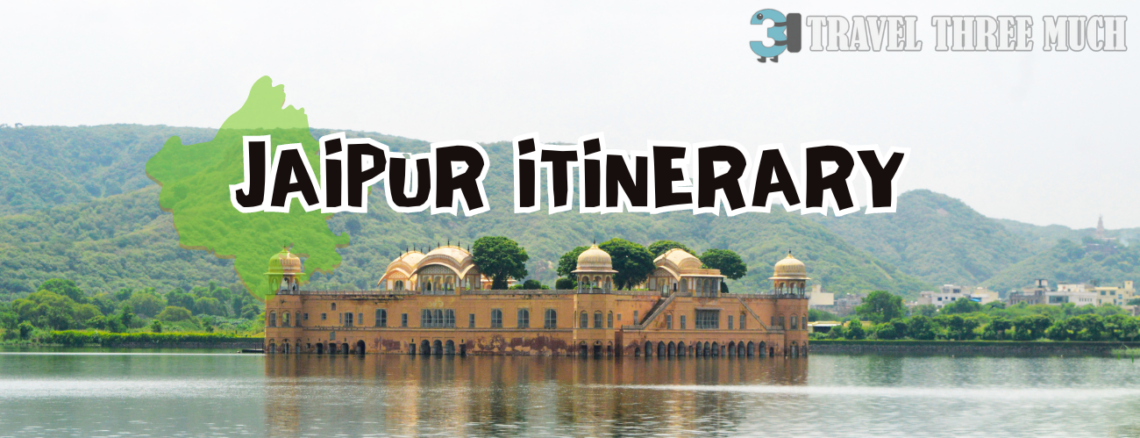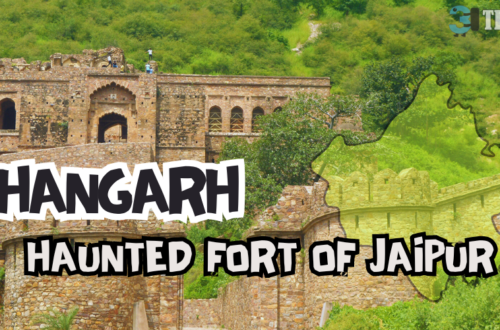
Our 4 day Jaipur Itinerary
The excitement started to build two months before August 2022. We had been reading about the culturally rich ‘Pink city’ since our school days and finally we had our itinerary planned! August being the rainy season in most parts of India, Rajasthan seemed like one of the best options for the holidays around India’s Independence Day weekend.
Below is a snapshot of our itinerary for 4 days in Jaipur.

Jaipur Itinerary – Day 1
We started from Bangalore in the morning and reached our hotel in Jaipur by the afternoon. A laid back Day 1 was planned.
Maharaniyon ki Chhatriyan
We had planned to visit Maharaniyon ki Chhatriyan only because it was just diagonally opposite to the hotel we were staying in. When we reached the place, it was empty. The oasis of calm in a busy city like Jaipur was a perfect start to our long-awaited trip.
Read about our visit to the Chhatriyans of Jaipur here.
Gaitore ki Chhatriyan
Our next stop was the delightful Gaitore ki Chhatriyan.

Masala Chowk
Yes! Food is very much a part of every itinerary. Whenever we visit a place, we look out for must-try food options and local cuisine and try to make it a point to eat in such places only. Nothing fancy or expensive, but authentic. Masala chowk is a good option for anyone who wants to explore the local Rajasthani cuisine. This open air food court has an entry fee. But it is justified because it’s clean, well-maintained, pleasant and most importantly, has some of the best food options. You can get kachoris, amazing chai options, ice creams and more.
Due to its excellent location and extremely pocket friendly prices, we ended up going there more than once during our trip and tried different options each time.
On day 1, we had planned to visit Albert hall museum at night. We had an early dinner since the museum is closed from 5-7 pm. After our dinner at masala chowk, we headed to the museum which is just a minute away.
Albert Hall Museum
Albert hall museum is quite huge and it’s a treasure trove of information.
The museum complex consists of the ground floor and a first floor. The ground floor is mainly an indoor courtyard where a puppet show is run using Rajasthani puppets dancing to traditional and Bollywood numbers. The show’s highlight is a segment involving a snake which has to be experienced live, we’ll not spoil any more of it for you! 😉
The museum‘s first floor is accessed by a staircase which has a giant mural of a Gopatha/Godhra, the Zoroastrian winged bull with a human face. There are various sections dedicated to the art schools of the Deccan and South India, miniature art schools of Mughal and Indian dynasties, a collection of clothing from around the world, Chinaware and metalware from Oriental Asia.
It also has a permanent exhibition on the Egypt from the time of the pharaohs with the highlight – a mummy of a teenage girl named Tutu, from a family of devotees of the deity Kehm.
This museum is a must visit for anyone with even the slightest interest in history and art. The artefacts displayed are not just from India but from various parts of the world curated by the British travelers over decades.
Our map for Day 1
Jaipur Itinerary – Day 2
Jantar Mantar
Jantar Mantar was our first stop on Day 2. Since the place tends to get a bit crowded, we reached there by 9:00 AM, as soon as the place opened. Although we had read up a bit regarding each instrument, we hired a guide to understand the working of these huge astronomical instruments.
YOU MAY ALSO LIKE : JANTAR MANTAR, JAIPUR
Some of the instruments that can seen in the Jantar Mantar of Jaipur are Samrat Yantra, Krant Writa Yantra, Jai Prakash Yantra, Rama Yantra and Rashivalay Yantra.


We couldn’t help but wonder how in that day and age they were able to create such accurate instruments when we have trouble drawing a 45 degree triangle on a piece of paper!
City Palace
The City Palace is just a 5 minute walk from Jantar Mantar and so that was the next place on our itinerary. This palace that lies in the heart of the city of Jaipur was built by Maharaja Sawai Jai Singh II.
The City Palace has three entrance gates – Udai Pol and Virendra Pol, open to the general public, and the Tripolia Pol, reserved for the use of the royal family.

There are many galleries showcasing the royal life, crafts and weaponry of the Kachhwaha Rajputs. The first gallery that we visited was called the Textile Gallery, on the ground floor of the Mubarak Mahal and had various clothing used by the article, including a rare pashmina carpet, partially preserved from the 17th century.

The gallery also has the sporting achievements of the royalty in polo. The gallery also has a small shop from which one can buy clothing made by the kaarigars (crafts persons), trained in the arts of making clothing for royalty. The next gallery we visited was an arms and armour gallery.

This was followed by a visit to a painting and photography gallery. The gallery showcases the various schools of art that enjoyed the patronship of the king.
There was also a section that detailed the making of Wasli paper, used to paint exquisite miniatures. Interestingly, the paper has the insecticide copper sulphate incorporated in its making to ensure longevity and the surface is smoothened with sea shells or glass, minimizing the grain and making it perfect for the precise line work needed for the miniatures.
The next stop was the Sabha Niwas or the Hall of Audience where the thrones and chairs were arranged in a durbar setting.

There were a series of paintings of the different Kachhwaha rulers of Jaipur, descriptions of the circumstances under which they came to power and the tenure of their rule.
We made our way out of this hall to the Diwan-I-Khas or the Hall of Private Audience. This is a large hall which is open on all four sides.
The hall has two large silver urns in which water from the river Ganges was carried for the King’s travels outside of India.
The urns reportedly hold 4,000 litres of water each and are the world’s largest single object made from silver (as they have no soldered joints commonly associated with large silver vessels). We also visited a gallery where the artists use natural pigments and minerals to make their own watercolours and have works in both contemporary style and the Jaipur school of miniature paintings, available for sale. You can also catch a glimpse of how these works of art come to life if you can spare the time to watch the artisans at work.
Hawa Mahal
Hawa mahal, or the palace of wind is an iconic monument of Jaipur. The first time I saw this place with my head out of the tuk-tuk – memorable indeed!!
The Eastern façade of the Hawa mahal is the most popular and is a lot of times the poster face for Jaipur. But as we enter the building and explore its insides, its equally beautiful.

Many local folks suggest to skip this tour of the inside of the hawa mahal, but our suggestion would be to spend at least an hour walking around and exploring the mahal.
All three of us love places that are calm and not crowded at all. But Jaipur, is just the opposite and Hawa mahal is always very, very busy.
In spite of the crowds there, we were able to enjoy the beauty of this building, its stained glass windows, the wooden traditional windows and the structure, were all very unique and added to the charm of this beauty.

A couple of other things that you should not miss are the buzzling market streets outside Hawa mahal and do go by the street after sunset; don’t miss this view!
Sisodia Rani Ka Bagh
After exploring some really ‘crowded’ places of Jaipur, this place was literally a breath of fresh air!
Our Map for Day 2
We did a major part of Day 2 on foot. So the below map shows the route we took. Only the last place, Sisodia Rani ka Bagh was done with Tum tums (local auto rickshaws)
Jaipur Itinerary – Day 3
While we planned our itinerary, we realised that we only had time to do 2 forts of Jaipur. Amer fort being the biggest, was a given. So we had to choose between the forts of either Nahargarh or Jaigarh. We then got to know that there is a tunnel that connects Amer fort with Jaigarh and that we could walk from one for to the other.
So, Jaigarh it was.
Amer Fort
We left for Amer fort early in order to avoid crowds as much as possible. On the way, we stopped for a bit to capture the reflection of the mighty fort.
The fort is beautiful with art just sprinkled across.


The only thing that was a bit of a mood spoiler was the behaviour of the guides at Amer Fort. We get that they need clients and tourists to make a living, but in most Indian tourist places, guides are polite; they offer their services and let us be if we are not interested, but not so at Amer Fort.
Anyway, when you are near the exit (opposite the huge iron wok), you can can find the way to tunnel that takes you to Jaigarh fort.
The tunnel walk
Walking through the tunnel was a very interesting experience. In most forts of India, such tunnels are kept closed. Being able to go through a fort tunnel by itself was a new experience.
Jaigarh Fort
We reached Jaigarh fort early and there weren’t many crowds yet.
Jaigarh fort was built by Sawai Jai Singh in 1726. The fort is built in sandstone and was used to store arms and ammunitions for warfare.

After an exhausting half day of walking quite a lot in both the forts, we came back to our hotel, ordered in and took a good nap!
Jaipur Zoo
In the evening, we took a tuk tuk and reached the Jaipur zoo near Albert Hall museum. Since our daughter loves zoos and animals, we never miss them. The zoo is small and can be covered within an hour’s time.
Jal Mahal
We made a brief pit stop here on the way back home from Jaigarh fort. Apparently, the Jal Mahal is embroiled in some sort of legal tussle and so no one’s allowed access to it.
The view was quite scenic and the placid lake’s surface was a welcome break from the hustle and bustle of the highway traffic. We could see many pelicans and cormorants on the shores of the lake, making their way to and from the lake’s centre.

Jaipur Itinerary – Day 4
Bhangarh Fort
Bhangarh fort is about two hours from Jaipur. The fort has very very few visitors and is a must visit although it could take up a day to visit Bhangarh and the stepwell of Abhaneri.
While we were looking for some offbeat destinations to visit near Jaipur, we came across the Abhaneri step well. And Bhangarh fort was interesting because of the haunted stories.
Abhaneri (Chand Baori Step well)
Most places of Jaipur are regal looking, colourful and pristine. Abhaneri and Bhangarh are two stunning places that look like the child of Jaipur and Hampi – Brilliant architecture with an old world charm. And because of this reason, these two places became our top favourites of the trip.

Our map for Day 4
We retuned back to Bangalore the next day with our head full of memories and the SD card full of pictures!





